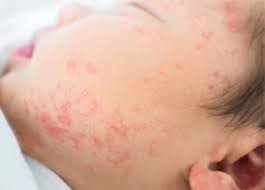Various skin rashes that occur in children from the newborn period cause anxiety from time to time. Child Health and Diseases Specialist Dr. Perihan Çobanoğlu Saf gave information about the 6 most common skin diseases.
In the newborn period, variegated rashes may occur due to the fact that the skin is much more sensitive and vulnerable to external factors. Underlining that neonatal rashes are much more innocent than supposed, Yeditepe University Kozyatağı Hospital Pediatric Health and Diseases Specialist Dr. Perihan Çobanoğlu Saf said, "While neonatal rashes may rarely be a symptom of major diseases, they are generally very innocent things."
"Mongolian Spot Don't Worry Mothers"
Providing information about the mongolian spot that is more common in dark-skinned babies, Uzm. Dr. Perihan Çobanoğlu Saf said, “It shows itself as a bruise that appears in the area extending from the waist to the hips. This situation, which may worry any mother who takes her baby in her arms, is actually completely unimportant. It is not known why the mongolian spot occurs. This spot observed at birth is in the form of a bruise extending upwards from the coccyx, which is at least 5-6 cm. It disappears around the age of 2 and is completely unimportant. "It has nothing to do with Down syndrome," he said.
"Milia Stain Disappears in 2 Weeks"
Exp. Dr. Perihan Çobanoğlu Saf said, “These spots that shine like pearls and do not cause any trouble are completely innocent and disappear in 1-2 weeks”
Most Common Toxic Erythema
Explaining that another common rash in his new period is 'toxic erythema', which is seen in the form of yellow-white swellings similar to acne, Dr. Perihan Çobanoğlu Saf continued as follows:
“This rash, which occurs within 1-2 days after birth, is not inflammatory contrary to its appearance and usually disappears within a week. However, if this stain occurs immediately after birth or 5-6 days later, if there is an accompanying restlessness, fever or if it does not regress within 3-4 days, it is necessary to consult a doctor.
Hemangiomas
After birth as a red stain on the baby's skin and worries many families, “Will there be any traces? Why would that happen? " Stating that the rash that causes concerns such as hemangiomas, Dr. Perihan Çobanoğlu Saf said, “For hemangiomas, which are usually observed on the eyelid, nostrils, upper lip, between the eyebrows and the neck, families are generally concerned that it will be permanent. These spots are popularly known as 'birthmark' or 'stork spot' (based on the legend of the redness where the stork grabs the baby with its beak at the neck while bringing it). Although these known spots are attributed to the consumption of red fruits such as strawberries and pomegranates while pregnant, they have nothing to do with it.
These rashes, ranging from light red 1-2 cm to 5-6 cm, are generally not puffy from the skin. However, in cases where it is intense, swelling may occur. It is caused by the condensation and expansion of capillaries to form a ball of veins. It becomes more apparent when the baby cries, laughs while pushing. Large and dense ones can grow from around 4-5 months to 1-1.5 years old and then begin to shrink. It mostly disappears around 4-5 years old. In some cases, hemangiomas that are raised from the skin may require treatment. These should be followed by a pediatrician. The other pink-red, non-puffy ones spontaneously disappear between the ages of 1-2 ”.
Precautions Against Heat Rash
Stating that the most common rash in babies is rash, Dr. Perihan Çobanoğlu Saf continued as follows:
“It occurs as a result of clogging of sweat glands in hot weather. Since the pores of sweat are also small in younger babies, it is more common. This is due to the fact that babies are dressed thicker than necessary in hot weather. First of all, in order for the baby's skin to breathe, clothes should be chosen as thin as possible and absorb sweat. You should take a bath frequently. It should be kept in airy environments. He should change his diaper frequently and ventilate for at least 15 minutes a day. Things like baby oil or heavy moisturizers should not be applied to the skin unless necessary. Complaints usually resolve spontaneously with these care suggestions. However, in cases where rash is common, it may be necessary to use lotions recommended by the pediatrician. "
Seborrheic Dermatitis
Yeditepe University Hospital Child Health and Diseases Specialist Dr. Perihan Çobanoğlu Saf explained the following about treatment:
“In rare cases, these babies may require the use of zinc or cortisone cream under the doctor's supervision. The common form that forms on the scalp is called the host. Softening it with olive oil, washing it with shampoos produced for babies every other day, and then combing it with the back of the comb, ie the flat part, will alleviate the situation, but it should never be removed by force. Atopic dermatitis, which is rash and allergic, is also one of the common problems.



0 Comments